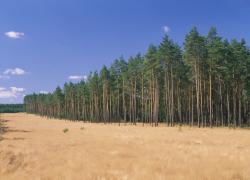 Asset Publisher
Asset Publisher
Polish forests
Poland is in the European lead, while concerning the area of all forests. They cover about 29,2 % of the country territory, and grow within the area of 9,1 million hectares. The overwhelming majority of the forests is state owned, of which almost 7,6 million hectares are managed by the State Forests National Forest Holding..
The number of Polish forest is still growing. The forestation rate of the country has increased from 21 % in 1945 to 29,2 % at the moment. Between 1995 and 2008, the forest area increased by 310 thousand ha. The basis for afforestation works is the "National Programme for Increasing the Forest Cover" (KPZL), assuming an increase of the forestation rate up to 30 % by 2020 and up to 33 % by 2050. Polish forests abound in flora, fauna and fungi. 65 % of the total number of animal species live there.
The forests grow in our country on poor soils, mainly because of the development of the agriculture in previous years. It influences the distribution of the types of the forest sites in Poland. Over 55 % of the forest areas is covered with coniferous forests. In other areas, there are forest sites, mainly the mixed ones. Their small part constitute alder and riparian forests – not more than 3 %.
In the years 1945 – 2011 the area of natural deciduous tree stands within the area of the State Forests National Forest Holding increased from 13 to 28,2 %.
Within the lowlands and uplands the most often occurring tee species is pine. It covers 64,3 % of the forest area of the State Forests National Forest Holding and 57,7 % of private and commune forests. In the mountains the predominant species is European spruce ( in the west) and European spruce with beech (in the east). Domination of pine is the result of carrying on sustainable forest management in the past. Once, the monocultures (crops or cultivations of one species) were the answer to the great demand of industry for wood. Such forests appeared to be quite fragile to climatic factors. They also were often the prey of pests' expansion.
In Polish forests, the share of other tree species, especially deciduous trees have been systematically increasing. The foresters have stepped aside from monocultures – that is why, they try to fit specific species of the forest stand to the natural stand, that would be proper for the given area. Thanks to that, in the years 1945 – 2011, the area of the deciduous tree stands within the lands of the State Forests National Forest Holding increased from 13 to 28,2 %. There occur more and more frequently the following tree species: oaks, ashes, maples, sycamore maples, elms, but also birches, beeches, alders, poplars, hornbeams, aspens, tilias and willows.
Our forests are the most often represented by the forest stands aged 40 to 80 years. The average age of the forest equals 60 years. More and more trees are of big size at the age over 80 years. Since the end of the Second World War, the forests' area has increased up to almost 1,85 million hectares.
Raport o stanie lasów w Polsce 2012
 Asset Publisher
Asset Publisher
 Asset Publisher
Asset Publisher
Leśny Kompleks Promocyjny "Puszcza Świętokrzyska"
Leśny Kompleks Promocyjny "Puszcza Świętokrzyska"
Leśny Kompleks Promocyjny Puszcza Świętokrzyska obejmujący obszar o łącznej powierzchni 76 885 ha znajduje się w całości w granicach Regionalnej Dyrekcji Lasów Państwowych w Radomiu. W jego skład wchodzi 6 nadleśnictw: Zagnańsk, Daleszyce Łagów, Suchedniów, Kielce oraz Skarżysko (obręb leśny Rataje).
Powołany został Zarządzeniem Nr 75 Dyrektora Generalnego Lasów Państwowych w dniu 13 grudnia 2004 roku, a powiększony w oparciu o Zarządzenie Nr 43 z 3 sierpnia 2007 roku oraz Zarządzenie Nr 26 z 26 marca 2008 roku. Jest obszarem o znaczeniu społecznym, ekologicznym, edukacyjnym, kulturowym, historycznym i naukowym.
Głównymi celami działania LKP Puszcza Świętokrzyska jest promocja trwale zrównoważonej gospodarki leśnej, ochrona zasobów przyrody w lasach oraz edukacja leśna społeczeństwa
LKP znajduje się w całości na terenie woj. świętokrzyskiego i zajmuje pokaźny obszar dawnej Puszczy Świętokrzyskiej. Regionalizacja przyrodniczo-leśna zalicza obszar LKP do VI Krainy Małopolskiej, mezoregionów: Łysogórskiego i Puszczy Świętokrzyskiej. LKP obejmuje wyżynne, podgórskie i górskie kompleksy leśne otaczające Świętokrzyski Park Narodowy, ze znacznym udziałem drzewostanów naturalnych, zwłaszcza jodłowych i bukowych z domieszką jawora, graba i modrzewia. Specyfiką gospodarki leśnej na tym obszarze jest naturalne odnawianie się lasu, zwłaszcza jodły. Zróżnicowanie geologiczne i wysokościowe powoduje znaczną mozaikowatość gleb, co wpływa na urozmaicony skład gatunkowy lasu i występowanie drzewostanów mieszanych. Cały obszar LKP leży w zlewniach rzek stanowiących lewobrzeżne dopływy środkowej Wisły, tj. Nidy, Czarnej Staszowskiej, Koprzywianki, Kamiennej, lłżanki i Pilicy.
Obszar LKP należy do najcenniejszych obszarów przyrodniczych, krajobrazowych i kulturowych regionu świętokrzyskiego. Świadczy o tym istnienie 5 parków krajobrazowych, 3 obszarów chronionego krajobrazu, 24 rezerwatów przyrody, 21 użytków ekologicznych, 3 zespołów przyrodniczo-krajobrazowych oraz 42 pomników przyrody, a także duża liczba miejsc związanych z wydarzeniami historycznymi i obecność zabytków kultury materialnej.


 fot. Paweł Fabijański
fot. Paweł Fabijański
 fot. Paweł Fabijański
fot. Paweł Fabijański
 fot. Paweł Fabijański
fot. Paweł Fabijański







